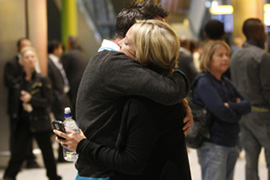Airports reopen across Europe
More planes take to the air but long backlog means many travellers still stranded.

“The situation today is much improved,” Brian Flynn, deputy head of operations at Eurocontrol, said.
The agency predicted that the number of take-offs and landings would be close to normal by Friday.
Slow resumption
Airspace in Germany remained officially closed on Tuesday, but airlines were permitted to operate a limited number of flights under so-called visual flight rules.
|
Lufthansa said it planned to carry more than 15,000 passengers on some 200 flights, around 11 per cent of its normal daily schedule.
Airspace over northern Italy also slowly reopened with flights leaving Rome and Milan. Flights also began landing at Belgian airports.
In France, Dominique Bussereau, the transport minister, said 30 per cent of scheduled national and international flights would fly from Paris
airports.
Some of the millions of passengers estimated to have been stranded by the restrictions cheered and applauded as they were told that they would be allowed to resume their journeys.
“Everyone was screaming in the airplane from happiness,” Savvas Toumarides of Cyprus, who finally arrived in New York after getting stuck in Amsterdam for five days, told The Associated Press news agency.
He said that the worst part of his journey was “waiting and waiting and not knowing”.
Bob Basso of San Diego, who has been staying near Charles de Gaulle airport in Paris since his flight was cancelled on Friday, said: “We were in the hotel having breakfast, and we heard an aircraft take off. Everybody got up and applauded.”
Basso and his son had tickets for a flight to Los Angeles later on Tuesday.
Al Jazeera’s Imran Khan, reporting from Heathrow airport, said: “Planes are coming in every couple of minutes and obviously that it a very joyous sight for a lot of those stranded travellers.
“When people were watching the arrivals board and saw the sign that said ‘landed’ there were screams of excitement.”
However, with more than 95,000 flights cancelled across the world it will be some time before the airlines are able to clear the backlog of passengers.
Passenger backlog
British Airways, which cancelled about 500 flights a day in the past five days, said it was trying to clear its backlog on a case-by-case basis.
| In video |
|
Al Jazeera’s David Chater reports on the erupting volcano in southern Iceland |
It said travellers could either rebook online or claim a full refund, and it also urged travellers booked to fly this week to consider cancelling their trips so that it could maximise space to fly people home.
Spain’s Iberia said it was coping with the backlog by using bigger aircraft and adding extra flights.
“We’ve never had a backlog like this before,” Laurie Price, the director of aviation strategy at consultant Mott Macdonald, said.
“After 9/11 airspace was shut for three days, and then the US airlines were bailed out by the government.”
Britain had delayed reopening the major air hubs in the capital amid fears that a fresh ash cloud was heading towards the area.
The Civil Aviation Authority said it was possible to lift many of the restrictions after experts studied the ash cloud from the Icelandic volcano and aircraft manufacturers “agreed increased tolerance levels in low ash density areas”.
“The new guidance allows a phased reintroduction from 2200 [21:00 GMT] tonight of much of the airspace which is currently closed due to the volcanic ash plume over the UK,” it said in a statement.
The restrictions had already been eased in Scotland and some parts of northern England.
‘Activity decreasing’
Iceland’s civil protection department said that activity at the Eyjafjallajokull volcano had reduced on Tuesday.
 |
| There was relief for those reunited with families but many remain stranded [Reuters] |
“We have some indications that the activity is decreasing. We have less ash fall, and also there seems to be a little less activity in the crater,” Rognvaldur Olafsson, the agency’s chief inspector, told the Reuters news agency.
“You have to choose your words very carefully but at least the scientists tell us that the activity is going down. We cannot make the assumption that the worst is over but we hope it is.”
On Monday, European Union transport ministers reached a deal during a crisis video conference to divide northern European skies into three areas: a no-fly zone immediately over the ash cloud; a caution zone “with some contamination” where planes can fly subject to engine checks for damage; and an open-skies zone.
Peter Ramsauer, the German transport minister, said all aircraft under the “control zone” plan will be thoroughly checked once they have landed.
“Much stricter tests and checks will be applied to all planes,” Ramsauer said, in hopes of gaining more data about the risk from the ash.
The move to ease flight restrictions came after criticism from carriers, who said test flights in recent days by airlines including KLM, Lufthansa and British Airways suggested planes could fly safely despite the ash and that the danger was exaggerated.
None of the test flights reported problems or damage.
